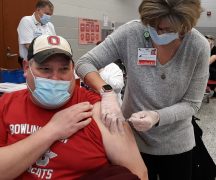By JAN McLAUGHLIN
BG Independent News
Public health saw the downward trend of cigarette smoking as a success story. Whether people were stopping for their health, their wallets, or because few public places allowed smoking anymore, it didn’t matter. What mattered was that fewer people were ingesting the carcinogens or sharing the risks with people around them.
But then the vaping trend ticked up. Smokers viewed vaping as a way to wean themselves off cigarettes, and others saw it as a safe alternative to cigarettes.
Both viewpoints are risky and wrong, according to public health officials.
The increase in vaping is being seen at college campuses across the nation. So who better to enlist in the fight against vaping than college students themselves?

Eight public health and health education students from Bowling Green State University and the University of Toledo have been working with the Wood County Health Department to make people aware of the dangers of nicotine in all its forms – vaping, cigarettes, and Zyn flavored pouches that are placed under the upper lip.
The students, working with Wood County Health Department health educator Leah Budke, have studied several issues involving nicotine, such as:
- Messaging that people encounter everyday promoting vaping and Zyn pouches.
- Strategies that people can use to say “no” to nicotine at parties or in groups.
- Peer counseling at community events.
Vaping remains the most common method of nicotine consumption among adolescents, and seems to have replaced or supplemented the use of cigarettes.
But vaping is far from harmless. The process typically delivers nicotine, harming the developing brain, according to the 2024 report on Behavioral Health Barometer among Wood County youth. Teens are particularly vulnerable to the effects of nicotine since the brain is still developing during these years through young adulthood.
While vaping has seen a decline among high school students, the rates among college students remain high, according to Beth Peery, director of education and engagement at the Wood County Health Department.
National studies have shown that 75% of college students have tried vaping nicotine, and nearly 25% use it every day, Peery said.
“It’s easier for a younger person to get addicted,” Peery said. “It’s easier to consume more nicotine with vaping since it tastes good.”
The eight college students working with the Wood County Health Department all have people in their lives who they have tried to convince to stop using tobacco – roommates, friends, family members. They agree it’s easier to talk about the dangers of nicotine with strangers since there are no repercussions.
“Speaking up might not be the cool thing to do,” BGSU student Alyssa Hoerig said. “But let your friends know it’s coming from a place of love.”
Vaping is less conspicuous than cigarettes in public places, the students said.
“It’s easier to get away with. It’s easier to hide it,” Hoerig said.
Plus it’s marketed as “fruity” and “fresh” with flavors like watermelon and cotton candy.
Vaping is promoted as chic and modern – and compact, now being the size of a flash drive, BGSU student Alex Wood said.
“Not to say tobacco smoking has been stamped out,” but vaping is considered to be safer and easier to hide, Wood said.
While the legal age for purchasing is 21, vapes are often sold out of vending machines.
“The companies are in the business of addicting you,” Wood said.
The students all know people who have ditched cigarettes for vaping.
“They used to say it’s safer than smoking. But the more research says it isn’t,” Wood said.
The Zyn pouches are also in a honeymoon period, often advertised as “tobacco leaf free.” They are flavored and cleaner than chewing tobacco, but provide a quick release of nicotine, linked to lip and lung cancer.
“It’s definitely a big social thing. It spirals from there,” Hoerig said.
“They all think they can quit when they want to,” said UT student Jochebed Boalye Ansah.
In some cases, the best approach with friends using nicotine may be using tough love.
“Smoking is going to give you cancer, make your gums deteriorate, give you high blood pressure and anxiety,” Hoerig said.
“It will make you dumb,” Ansah added.
The students took what they learned and made their own marketing campaign to convince people to not start, or quit using tobacco. They developed tips on how people can decline offers to smoke, and ways to make people aware of the risks.
According to Johns Hopkins Medicine, research suggests vaping is bad for hearts and lungs. Electronic cigarettes aren’t the best smoking cessation tool, since e-cigs are just as addictive as traditional ones.
The result is a whole new generation getting hooked on nicotine.
According to the Centers for Disease Control:
- A person using an e-cigarette inhales aerosol into their lungs. Bystanders can also breathe in the aerosol when the person using the e-cigarette breathes the aerosol out.
- E-cigarettes typically contain nicotine, the addictive substance in cigarettes and other tobacco products. Some e-cigarettes can also be used to deliver cannabis and other drugs.
- E-cigarettes often come in bright colors. They are also available in flavors that appeal to young people, like fruit, candy, menthol, and mint.
- As of September 2023, more than 6,000 different e-cigarette products were available for purchase in the U.S. Disposable e-cigarettes in youth-appealing flavors are the most commonly sold device type.
- Between February 2020 and September 2023, the percentage of disposable e-cigarettes sold more than doubled from 26% to 57.2%. In that same time period, the percentage of prefilled cartridges decreased from 73.9% to 42.8%.
- In September 2023, 80.1% (18.4 million units) of e-cigarette sales were for flavors other than tobacco, such as fruit or menthol.
- In September 2023, e-cigarette sales totaled $524.6 million





